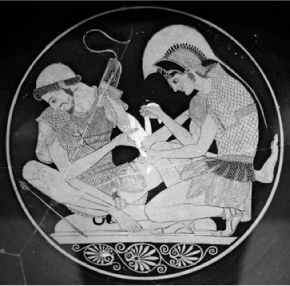Cycladic, Minoan, Mycenaean, and Archaic Greek MythologyThe Mycenaens and Homer |
Who were the Mycenaeans? |
The Mycenaeans were a Greek-speaking people who arrived in Greece sometime around 2000 B.C.E. and whose major centers are known to us primarily through the epics of Homer. Most important of these cities was Mycenae, the city of the quasi-legendary King Agamemnon, the leader of the Greeks—also called Achaeans or Danaans—in the Trojan War described by Homer in the Iliad. The Mycenaeans, unlike the Minoans, were a warlike people with castle towns dominated by princely aristocrats. They did have advanced jewelry, architecture, and other arts and crafts, however, and were influenced in these pursuits, as in their religion and mythology, by the Minoans, whom they conquered in about 1400 B.C.E.
Other than the list of deities listed above, little is really known about Mycenaean religion and mythology. Linear B was not conducive to literary practices. Stories and myths would have been told orally and passed down through the generations that way. As the Minoan-Mycenaean deity list indicates, we can say, however, that many of the Olympian gods whom we associate with the mythology of classical Greece were already known and presumably worshipped in Mycenae.
The Mycenaean civilization had fully deteriorated by 1100 B.C.E. for reasons that are unclear but that perhaps can be attributed to the invasion of another Greek-speaking people, the Dorians. In any case, the end of the Mycenaean civilization marked the beginning of the so-called Dark Ages in Greece, a period of social and cultural stagnation that lasted until the emergence of a new writing system in the late eighth century B.C.E., a system in which an alphabet devised by the Phoenicians was adapted to Greek. The end of the Dark Ages and the beginning of the so-called Archaic Age was also marked by the two poets, known to us as Homer and Hesiod, who probably composed orally sometime in the eighth century B.C.E.
Our view of the Mycenaeans is derived in great part not only from archeological ruins, but from Homer’s description of them in his epics. It should be remembered, however, that Homer had no written historical records on which to build; he would have depended for his sources on a word-of-mouth transmission of stories that spanned a period of 350 to 400 years.

A circa 500 B.C.E. piece of pottery is decorated with a scene from the Trojan War in which the hero Achilles assists the wounded Patroclus.
